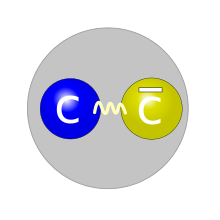This article needs additional citations for verification. (June 2023) |
 | |
| Composition | c c |
|---|---|
| Statistics | bosonic |
| Family | meson |
| Interactions | strong, weak, electromagnetic, gravity |
| Symbol | J/ψ |
| Antiparticle | self |
| Discovered | SLAC: Burton Richter et al. (1974) BNL: Samuel Ting et al. (1974) |
| Types | 1 |
| Mass | 5.5208×10−27 kg 3.096916 GeV/c2 |
| Decay width | 92.9 keV |
| Decays into | 3 g or γ +2 g or γ |
| Electric charge | 0 e |
| Spin | 1 ħ |
| Isospin | 0 |
| Hypercharge | 0 |
| Parity | −1 |
| C parity | −1 |
The
J/ψ
(J/psi) meson /ˈdʒeɪ ˈsaɪ ˈmiːzɒn/ is a subatomic particle, a flavor-neutral meson consisting of a charm quark and a charm antiquark. Mesons formed by a bound state of a charm quark and a charm anti-quark are generally known as "charmonium" or psions.[1] The
J/ψ
is the most common form of charmonium, due to its spin of 1 and its low rest mass. The
J/ψ
has a rest mass of 3.0969 GeV/c2, just above that of the
η
c (2.9836 GeV/c2), and a mean lifetime of 7.2×10−21 s. This lifetime was about a thousand times longer than expected.[2]
Its discovery was made independently by two research groups, one at the Stanford Linear Accelerator Center, headed by Burton Richter, and one at the Brookhaven National Laboratory, headed by Samuel Ting of MIT. They discovered that they had found the same particle, and both announced their discoveries on 11 November 1974. The importance of this discovery[citation needed] is highlighted by the fact that the subsequent, rapid changes in high-energy physics at the time have become collectively known as the "November Revolution". Richter and Ting were awarded the 1976 Nobel Prize in Physics.
- ^ Kapusta, J.; Müller, B.; Rafelski, J. (9 December 2003). Quark-Gluon Plasma: Theoretical Foundations: An Annotated Reprint Collection. p. 462. ISBN 9780444511102. Retrieved 25 September 2014 – via Google Books.
- ^ "Shared Physics prize for elementary particle" (Press release). The Royal Swedish Academy of Sciences. 18 October 1976. Retrieved 23 April 2012.